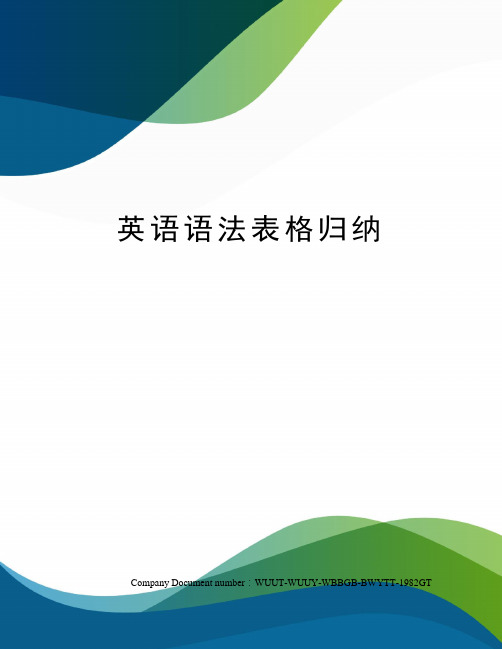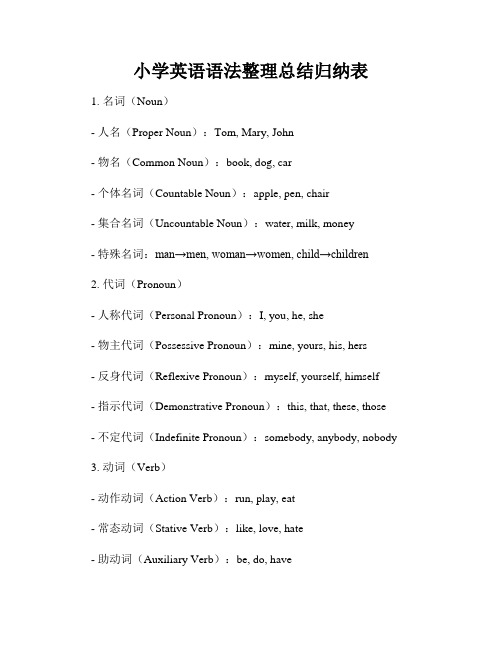英语语法总结表格
英语语法体系表

语法网络图一.名词1. 规则名词的复数形式:名词在句中表示所有关系的语法形式叫做名词所有格.所有格分两种:一是名词词尾加’s构成,二是由介词of加名词构成。
前者多表示有生命的东西,后者多表示无生命的东西。
用于无生命的东西:the legs of the chair, the cover of the book用于有生命的东西,尤其是有较长定语时:the classrooms of the first—year students用于名词化的词:the struggle of the oppressed二.冠词冠词分为不定冠词(a, an),定冠词(the),和零冠词。
1. one, some与any:1) one可以泛指任何人,也可特指,复数为ones。
some多用于肯定句,any多用于疑问句和否定句。
One should learn to think of others.Have you any bookmarks? No, I don’t have any bookmarks。
I have some questions to ask.2) some可用于疑问句中,表示盼望得到肯定的答复,或者表示建议,请求等。
Would you like some bananas? Could you give me some money?3) some 和any修饰可数名词单数时,some表示某个,any表示任何一个。
I have read this article in some magazine。
Please correct the mistakes, if any。
4) some和数词连用表示“大约”,any可与比较级连用表示程度。
There are some 3,000 students in this school. Do you feel any better today?2。
each和every:each强调个别,代表的数可以是两个或两个以上,而every强调整体,所指的数必须是三个或三个以上。
英语16种时态表格总结

英语16种时态表格总结时态是英语语法中非常重要的一部分,它们用于表示动作发生的时间、顺序和持续性等信息。
了解和掌握英语的各种时态对于学习语言的人来说至关重要。
本文将总结英语中常用的16种时态,并提供表格形式的概览,方便读者更好地理解和运用。
一、一般现在时(Simple Present)表示经常性、习惯性、客观真理形式,以及现在的动作、状态等。
肯定句:主语+动词原形否定句:主语+do/does not+动词原形疑问句:Do/Does+主语+动词原形?二、一般过去时(Simple Past)表示过去某个时间发生的动作或状态。
肯定句:主语+动词过去式否定句:主语+did not+动词原形疑问句:Did+主语+动词原形?三、一般将来时(Simple Future)表示将要发生的动作或状态。
肯定句:主语+will+动词原形否定句:主语+will not+动词原形疑问句:Will+主语+动词原形?四、现在进行时(Present Continuous)表示现在正在进行的动作或状态。
肯定句:主语+am/is/are+动词现在分进行否定句:主语+am/is/are not+动词现在分进行疑问句:Am/Is/Are+主语+动词现在分进行?五、过去进行时(Past Continuous)表示过去某个时间正在进行的动作或状态。
肯定句:主语+was/were+动词现在分进行否定句:主语+was/were not+动词现在分进行疑问句:Was/Were+主语+动词现在分进行?六、将来进行时(Future Continuous)表示将来某个时间正在进行的动作或状态。
肯定句:主语+will be+动词现在分进行否定句:主语+will not be+动词现在分进行疑问句:Will+主语+be+动词现在分进行?七、现在完成时(Present Perfect)表示过去发生的动作对现在造成的影响或结果。
肯定句:主语+have/has+动词过去分词否定句:主语+have/has not+动词过去分词疑问句:Have/Has+主语+动词过去分词?八、过去完成时(Past Perfect)表示过去某个时间之前发生的动作。
英语语法总结表格

初中英语语法总结一览表
句型转换练习专项指导
①一般现在时:
含有be动词的:He is a student
一般疑问
否定:
特殊疑问句
非单三:we like reading in the moring.
一般疑问
否定:
特殊疑问句
单三:He likes reading in the morning.
一般疑问
否定:
特殊疑问句
②一般过去时:
含有be动词的:he was a student five years ago.
一般疑问
否定:
特殊疑问句
动词过去式的:They went to Ben Jing last week.
一般疑问
否定:
特殊疑问句
③一般将来时:He will go to the Great Wall in two days. 一般疑问
否定:
特殊疑问句
④现在完成时:She has already finished her homework. 一般疑问
否定:
特殊疑问句。
英语语法表格归纳

stand
stood
hang
hung
steal
stole
have
had
swim
swam
hear
heard
take
took
hold
held
teach
taught
hurt
hurt
tell
told
keep
kept
think
thought
know
knew
understand
understood
lay
He/she/it has
He/she/it had
We are
We were
We have
We had
You are
You were
You have
You had
They are
They were
They have
They had
infinitive
Past simple
infinitive
Past simple
tall
taller
tallest
rich
richer
richest
easy
easier
easiest
thin
thinner
thinnest
fat
fattariest
silly
sillier
silliest
tiny
tinier
tiniest
funny
funnier
be
was, were
lose
lost
become
became
make
英语语法总结表格

现在完成进行时
Have/has+been+动词 ing
表示过去发生,持续到 现在,将来还继续
since
It has been snowing since yesterday.
现在完成时 have / has+过去分词 发生在过去影响在现在 含 糊 的 频 率 副 词 already ; 分 词 规 则 的 同 过 不规则的动词的过去分
me.
将来完成时被动语态
情态动语被动语态 (can\must\may\have to\should)
1、 原有受词变名词 2、 动词变 will+have+动词过去分词 3、原有主词变成动词后面,前面加 by 1、 原有受词变名词 2、动词变情态动词+be+动词过去分词 3、原有主词变成动词后面,前面加 by
主:I will have written this letter.
主:I can play the piano.
動詞不定式主動語態及否定形式
被:This letter will have written by me.
被:The piano can be played by me.
時態
結構
例句
一般現在時 to do
3、原有主词变成动词后面,前面加 by
came.
1、 原有受词变名词
主:I was writing this letter 被:This letter was being
2、 动词变 have/has+been+动词过去分词
when you came.
written by me when you
3、原有主词变成动词后面,前面加 by
小学英语语法整理总结归纳表

小学英语语法整理总结归纳表1. 名词(Noun)- 人名(Proper Noun):Tom, Mary, John- 物名(Common Noun):book, dog, car- 个体名词(Countable Noun):apple, pen, chair- 集合名词(Uncountable Noun):water, milk, money- 特殊名词:man→men, woman→women, child→children2. 代词(Pronoun)- 人称代词(Personal Pronoun):I, you, he, she- 物主代词(Possessive Pronoun):mine, yours, his, hers- 反身代词(Reflexive Pronoun):myself, yourself, himself- 指示代词(Demonstrative Pronoun):this, that, these, those - 不定代词(Indefinite Pronoun):somebody, anybody, nobody 3. 动词(Verb)- 动作动词(Action Verb):run, play, eat- 常态动词(Stative Verb):like, love, hate- 助动词(Auxiliary Verb):be, do, have- 不规则动词(Irregular Verb):go→went, eat→ate, come→came 4. 形容词(Adjective)- 描绘性形容词(Descriptive Adjective):beautiful, big, happy- 物主形容词(Possessive Adjective):my, your, his, her- 限定性形容词(Limiting Adjective):this, that, these, those5. 副词(Adverb)- 时间副词(Time Adverb):now, then, tomorrow- 地点副词(Place Adverb):here, there, everywhere- 方式副词(Manner Adverb):quickly, slowly, well6. 介词(Preposition)- 时间介词(Time Preposition):in, on, at- 地点介词(Place Preposition):in, on, at- 方式介词(Manner Preposition):with, by, like7. 连词(Conjunction)- 并列连词(Coordinating Conjunction):and, but, or- 从属连词(Subordinating Conjunction):if, because, although 8. 冠词(Article)- 定冠词(Definite Article):the- 不定冠词(Indefinite Article):a, an9. 句子(Sentence)- 简单句(Simple Sentence):I eat an apple.- 复合句(Compound Sentence):She is smart, and she studies hard.- 复合句(Complex Sentence):I will go to the park if it doesn't rain.10. 语态(Voice)- 主动语态(Active Voice):The cat chased the mouse.- 被动语态(Passive Voice):The mouse was chased by the cat.以上是小学英语常见的语法知识总结归纳表,希望对你的学习有所帮助。
小学冀教版英语语法归纳总结表
小学冀教版英语语法归纳总结表一、词类(Parts of Speech)1. 名词(Noun)- 定义:表示人、动物、地点、事物等名称。
- 例子:book(书)、teacher(老师)、dog(狗)、London(伦敦)- 特点:可数(countable)和不可数(uncountable),可以具有所有格(possessive)形式。
2. 代词(Pronoun)- 定义:代替名词使用,常用于避免重复。
- 例子:I(我)、he(他)、it(它)、they(他们)- 特点:分为人称代词(personal pronouns)、物主代词(possessive pronouns)、反身代词(reflexive pronouns)等。
3. 形容词(Adjective)- 定义:修饰名词或代词,描述人或物的特征。
- 例子:beautiful(漂亮的)、happy(快乐的)、blue(蓝色的)- 特点:可以用于比较级(comparative)和最高级(superlative)形式。
4. 动词(Verb)- 定义:表示动作、状态或存在。
- 例子:run(跑)、eat(吃)、play(玩)- 特点:根据时态(tense)和语态(voice)的不同形式变化。
5. 副词(Adverb)- 定义:修饰动词、形容词或副词,表示时间、地点、方式等。
- 例子:quickly(快速地)、now(现在)、here(这里)- 特点:可以用于构成比较级和最高级形式。
6. 介词(Preposition)- 定义:连接词与其他词之间的关系。
- 例子:in(在)、on(在……上)、under(在……下)- 特点:常用于表示位置、方向、时间、原因等。
7. 连词(Conjunction)- 定义:连接词组、句子或句子的部分。
- 例子:and(和)、but(但是)、because(因为)- 特点:可以表示并列关系、递进关系、转折关系等。
8. 感叹词(Interjection)- 定义:表示强烈的情感或观点。
初中英语语法总结一览表(整理版)
初中英语语法总结一览表(整理版)初中英语语法总结一览表以下是初中英语语法总结一览表,包括动词的时态、用法和规则变化。
表示经常性的动作或状态,动词用原形,一般现在时,例如:He goes to school every day。
I often have lunch at home.一般现在时的第三人称单数动词加-s/es,例如:XXX.动词用过去时,一般过去时,例如:Are you going to read。
He is coming tomorrow。
Tom is writing now。
They are lying on the bed.Be动词的过去式是was/were,例如:I was happy yesterday。
They were at home last night.表示将来要做的事情,用be going to + 动词原形或will/shall + 动词原形,例如:I am going to watch a movie tonight。
She will visit her XXX.表示经常性的动作或状态的时间词,例如:XXX等。
动词规则变化包括-s/es和以辅音字母+y结尾的变为-ies,例如:She studies hard every day。
They fly to New York every summer.表示过去某个时间内的动作或状态,用表过去的时间词,例如:XXX等。
动词规则变化包括以-e结尾的动词加-d,以辅音字母+y结尾的变为-ied,例如:XXX.表示此时此刻正在进行的动作或状态,用现在进行时(be+动词ing),例如:XXX to music now。
They are looking at the pictures.表示将来某个时间或某段时间内要进行的动作或状态,用现在进行时(be+动词ing),例如:I am XXX.表示过去某个时间正在进行的动作,用过去进行时(was/were+动词ing),例如:I was XXX XXX.表示过去某个时间已经完成的动作或状态,用过去完成时(had+动词过去分词),例如:I had XXX by the time she arrived。
深圳牛津英语 一至六年级语法汇总表
特殊疑问句
What does your mother do? She’s a nurse. (Unit 6) What would you like? I’d like some tomatoes. (Unit 8) Where is it? It’s on the table. (Unit 9) How many squares are there? There are two squares. (Unit 11) How’s the weather? It’s warm and sunny. (Unit 12)
3A
一般疑问句 特殊疑问句
Are you Kitty? Yes, I’m. (Unit 3) How are you? I’m fine. Thank you. (Unit 2) Who is he? He’s my father. (Unit 5) How much is it? (Unit 8) How much are they? (Unit 8) How many boys? Three boys. (Unit 10) What is it? It’s a rabbit. (Unit 11)
祈使句
Put … in / on … (Unit 8) Yes, please. (Unit 9) No, thanks. (Unit 9) Loot at … (Unit 11) Don’t … (Unit 12)
2B
一般疑问句
Is it …? (Unit 2) Can you hear …? (Unit 3) Do you like (doing) …? (Unit 4) Would you like some …? (Unit 5)
陈述句
英语语法体系表
■合成名词: n+n、n+v、n+v-ing、v-ing+n、 v.+n、adj./+n.等。如: snowman
雪人, sunrise日出、 handwriting 笔迹
■合成形容词: adj.+n+-ed、adj.+v-ing、adj.+n、 n+v-ed、 n+v-ing,
合成 adv.+v-ed 等. 如: kind-hearted好心的、 easy-going 随和的、full-time 全
■原级修饰语 : quite,too,very, rather,pretty, a
little,just,almost,nearly
■比较级修饰语:
much,evern, still,(by)far,a lot,a great deal,a little,a bit
■最高级修饰语:(by)far, much, nearly,almost
■动词+名词:如;take care当心, keep watch 值班
■can/could: ①表示现在或过去的能力 ②表示可能性(一般用于否定句、疑问句) ③表示许可(给予许可不用coud)
■may/might:
①表示请求或给予许可
②表示可能性(一般不用于问句, might可能性比may小)
动
③表示祝愿(一般用倒装)
词
词法
名
■不可数名词不能以数目来计算,不可以分成个体,没有复数形式,不能用不定冠词
词 不可 修饰;若表示个体意义,要借助量词。
数名 ■不可数名词前可以用 (a) little, much, a good/ great deal of, a large
- 1、下载文档前请自行甄别文档内容的完整性,平台不提供额外的编辑、内容补充、找答案等附加服务。
- 2、"仅部分预览"的文档,不可在线预览部分如存在完整性等问题,可反馈申请退款(可完整预览的文档不适用该条件!)。
- 3、如文档侵犯您的权益,请联系客服反馈,我们会尽快为您处理(人工客服工作时间:9:00-18:30)。
一般现在时
动词用原形 表示经常性的 第三人称单数-s / es 动作或状态
Every often always Sometimes usually
一般过去时ຫໍສະໝຸດ 动词用过去式 表过去某个、段时间内 Be 动词用 was/ were 动作及状态 be going to+动词原 在将来某个时间或 形 某段时要做的事 will/shall+动词原形
Yesterday /last/ago /just now 一般加 ed /In1998 等 双写/ 辅+y 结尾-ied tomorrow / next / in+时间段
He wrote a letter yesterday. I studied hard last year. Are you going to read ? He is coming tomorrow . I will be watching TV tomorrow at eight. I will have finished this work by six o’clock tomorrow
据说他一直在写一些适合孩子们看的小说
結構 To love is to forgive. 愛就是寬恕
例句
現在完成進行時 To have been doing
否定形式直接在 to 前加 not.
主:I will have written this letter. 主:I can play the piano.
被:This letter will have written by me. 被:The piano can be played by me.
動詞不定式主動語態及否定形式 時態 一般現在時 現在完成時 現在進行時 to do I told him not to leave this house.我告知他不要離開這房子 To have done To be doing it is thought to have happened.被認為已經發生 You seem to be doing very well in America. 看来你在美国的生活过得很不错 He is said to have been writing some novels for children. 動詞不定式被動語態及否定形式 時態 一般現在時 完成時 結構 To be done To have been done 例句 Everyone likes to be loved. 每個人都喜歡被愛 It ought to have been done long ago 这事早该做完的
过去完成式被动语态
过去进行时被动语态
一般将来时被动语态
将来完成时被动语态 情态动语被动语态 (can\must\may\have to\should)
1、 原有受词变名词 2、 动词变 will+have+动词过去分词 3、原有主词变成动词后面,前面加 by 1、 原有受词变名词 2、动词变情态动词+be+动词过去分词 3、原有主词变成动词后面,前面加 by
一般将来时
将来进行时 将来完成时
Will+be+动词 ing/多 將來一段時間要進行的動 Tomorrow/after 用于复合句 作 will+have/has+ 动词 在將來要完成的動作或 Before 过去分词 狀態 be+doing listen look now 一般+ing 表此时此刻正进行的动 at the time Don’t…(祈使句) 去 e +ing 作或状态 双写+ing tie die lie – 变 ie 为 y 加 ing
现在进行时
Tom is writing now . They are lying on the bed . It has been yesterday. snowing since
现在完成进行时 现在完成时
Have/has+been+动词 表示过去发生,持续到 since ing 现在,将来还继续
have / has+过去分词 发生在过去影响在现在 含 糊 的 频 率 副 词 already ; 分 词 规 则 的 同 过 不规则的动词的过去分 I have been teaching for 8 years. yet;just; never; ever ;since;for 去式是一样的 词需逐个记忆 的动作或状态等 was / were +doing 多用于复合句中 had+动过去分词 多用于复合句中 would +动词原形 多用宾语从句中 at this time yesterday 表在过去某时间正在进 at that time;at nine yesterday 行的动作 evening 该动作发生在过去的过 by the time+过去时 when after before 去 过去看来将要发生的动 He said that he… the next day . 作或状态 tie die lie – 变 ie 为 y 加 ing 规 则 的 分 词 构 成 需要逐个记忆 与过去时一样的 详见不规则动词表 He was reading at that time last Friday We had learnt 2000 words by the end of last year. He said that he would come here the next day .
主:I am writing this letter.
现在进行式被动语态
被:This letter is being written by me.
现在完成式被动语态
主: I have written this letter. 被:This letter has been written by me. 主:I had written this letter before you came. 被:This letter had been written by me before you came. 主:I was writing this letter 被:This letter was being when you came. written by me when you came. 主:I will write this letter. 被: This letter will be written 主:I am going to see you. by me. You are going to be seen by me.
表示两个人、物 之间进行比较时
than /much/ a little far / in the two 等
She is the taller in the two. He runs faster than Tom . She is the most beautiful in her class.(最高级加 the)
.过去进行时
过去完成时
过去将来时
语法项目
构
成
用
法
象
征 词
规则变化 一般/去 e 双写/辅 +y 结尾-ier
不规则变化 好的多 坏的少 还有一远和一老
例
句
比较级形式 后--er 前加 more 形容副词名词 名词比较用 more 最高级形式 后-est 前加 most 形容副词名词 名词比较用 most
大于等于三个人、物之 in the +比较范围 间进行比较 of the 具体的数字
一般/去 e 双写/辅 bad/ill/badly-worst +y 结尾-iest far-farther-farthest
被动语态总结一览表
语法项目 无助动词的被动语态 有 助 动 词 肯 定 句 被 动 语 态 构成 1、 原有受词变名词 2、 动词变 be+动词过去分词(be 随人称时态而变) 3、 原有主词变成动词后面,前面加 by 1、 原有受词变名词 2、 动词变 is/am/are+being+动词过去分词 3、原有主词变成动词后面,前面加 by 1、 原有受词变名词 2、 动词变 have/has+been+动词过去分词 3、原有主词变成动词后面,前面加 by 1、 原有受词变名词 2、 动词变 had+been+动词过去分词 3、原有主词变成动词后面,前面加 by 1、 原有受词变名词 2、 动词变 have/has+been+动词过去分词 3、原有主词变成动词后面,前面加 by 1、 原有受词变名词 2、 动词变 will+be+动词过去分词 3、 原有主词变成动词后面,前面加 by 主:I saw a cat 例句 被:A cat was seen by me.
英语语法总结一览表
语法项目 构 成 用 法 象 征 词 规则变化 一般-s 以 s x ch sh 结尾 的加 es 辅音+y---ies 不规则变化 have----has He goes to school every day. I often have lunch at home. go-went come-came do-did leave-left 等 Go come leave Stay fly 等用进行表将来 例 句
